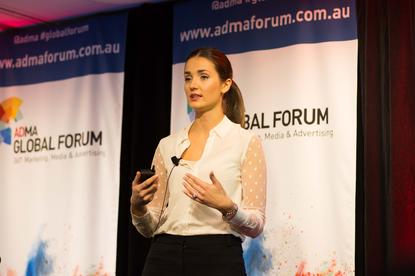Forethought: Brands need dual customer gain and retain digital strategy
- 07 August, 2015 08:45

ADMA Global Forum: Forethought’s Leanne Rosamlia speaks on effective customer retention and acquisition strategies to move a brand forward
Ann Lewnes, CMO, Adobe
Organisations must adopt a dual strategy of finding innovating ways to gain customers, and then retaining them, if they’re to grow their brand, according to a leading industry researcher.
Speaking at ADMA’s Global Forum in Sydney, Forethought’s Leanne Rosamlia said the marketing mix of product, place, price and promotion traditionally resided with the CMO.
“Marketing as a function has had control over these four areas,” she told attendees. “But what we’ve been observing more and more is a shift in focus towards different forms of marketing communication and creatives. We’re starting to see a divergence in emerging audiences when it comes to helping our clients grow their brands.”
Forethought is finding is the COO now holds custody of the customer experience and therefore the retention strategy of the brand, Rosamlia claimed, while the CMO looks after customer acquisition, and therefore attracting customers to the brand.
“So we now have these two divisions looking after different aspects of the customer,” she said. “But irrespective of where this responsibility lies, Forethought sees that in order to grow a brand, a dual strategy is required, which is finding innovating ways to gain customers, and then retain them.”
Based on this philosophy, Rosamlia claimed Forethought developed a suite of solutions to address both objectives of gain and retain and to help provide management focus on areas that will yield the greatest return.
“We know that decision-making is partly a rational decision, versus emotions, or these non-conscious feelings towards a category or towards brands,” she said. “Fundamentally, the value for marketers is come from understanding what discrete emotions are influencing or driving consumption behaviour in their category.”
According to Rosamlia, there are universal emotions that drive customer behaviour. Happiness, love, pride and contentment are the positive drivers, while anger, sadness and anxiety are negative drivers. But one emotion that can be positive or negative is surprise.
“We know it is a bit of a challenge to measure these, so we use metaphors to essentially gain this implicit measurement of how people are feeling towards a brand,” she said.
Meanwhile, on the rational side, Rosamlia said it is now well understood by marketers that consumers are weighing the price they are paying for a particular brand versus the quality they are receiving.
“Based on all these elements contributing to how people make decisions, what we do is utilise data models to quantify what informs rational considerations versus emotions,” she said. “Once we understand what drives brand choice, we can then understand what drives market share.”
Where marketing gets it right with customers is when the campaign is created with these key drivers of market expectations, enforced by what is happening in-store, she said. She pointed to Kmart as one example where customer’s perception of price and value for money were turned around by a successful advertising campaign that met customers’ key drivers.
“Marketing can do a fantastic job in attracting customers into a brand, but sometimes the overall sales doesn’t necessarily increase for the business,” she said. “But what we find is that on most occasions, the reason is the customer experience challenges are not being addressed. So marketing alone cannot be the only endpoint for channelling sales.
"The key is to constantly ask what you should be communicating to attract customers to the brand, and what you should be doing or fixing to ensure customers don’t leave the brand. As marketers, we need to start edging ourselves towards the retention, and customer experience discussion. Because at the end of the day, the brand’s strategy should be powerful enough to effectively change your position in market.”
Follow CMO on Twitter: @CMOAustralia, take part in the CMO Australia conversation on LinkedIn: CMO Australia, join us on Facebook: https://www.facebook.com/CMOAustralia, or check us out on Google+: google.com/+CmoAu

